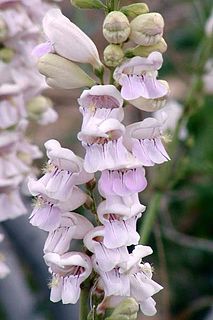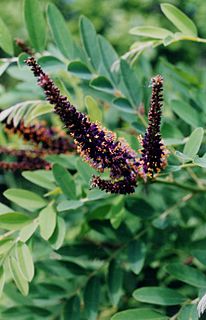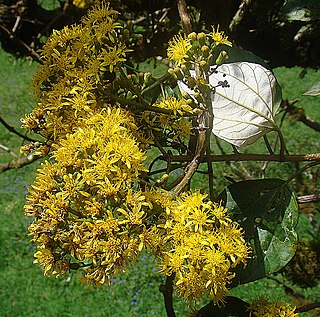Related Research Articles

Penstemon, the beardtongues, is a large genus of roughly 250 species of flowering plants native mostly to the Nearctic, but with a few species also found in the North American portion of the Neotropics. It is the largest genus of flowering plants endemic to North America. Formerly placed in the family Scrophulariaceae by the Cronquist system, new genetic research has placed it in the vastly expanded family Plantaginaceae.

Sphaeralcea is a genus of flowering plants in the mallow family (Malvaceae). There are about 40-60 species, including annuals, perennials, and shrubs. Most originate in the drier regions of North America, with some known from South America. They are commonly known as globemallows, globe mallows, or falsemallows. The name of the genus is derived from the Greek words σφαῖρα (sphaira), meaning "sphere," and αλκεα (alkea), meaning "mallow."

Antennaria is a genus of dioecious perennial herbs in the family Asteraceae, native to temperate regions of the Northern Hemisphere, with a few species in temperate southern South America; the highest species diversity is in North America. Common names include catsfoot or cat's-foot, pussytoes and everlasting.

Cercocarpus, commonly known as mountain mahogany, is a small genus of at least nine species of nitrogen-fixing flowering plants in the rose family, Rosaceae. They are native to the western United States and northern Mexico, where they grow in chaparral and semidesert habitats and climates, often at high altitudes. Several are found in the California chaparral and woodlands ecoregion.

Amorpha is a genus of plants in the pea family, Fabaceae. All the species are native to North America, from southern Canada, most of the United States (US), and northern Mexico. They are commonly known as false indigo. The name Amorpha means "deformed" or "without form" in Greek and was given because flowers of this genus only have one petal, unlike the usual "pea-shaped" flowers of the Faboideae subfamily. Amorpha is missing the wing and keel petals.

Claytonia is a genus of flowering plants native to North America, Central America, and Asia. The genus was formerly included in Portulacaceae but is now classified in the family Montiaceae, primarily native to the mountain chains of Asia and North America, with a couple of species extending south to Guatemala in Central America, and northwest to Kazakhstan, Mongolia, and Russia in eastern Asia.

Packera is a genus of about 64 species of plants in the composite family, Asteraceae. Its members were previously included in the genus Senecio, but were divided out based on chromosome numbers, a variety of morphological characters, and molecular phylogeny.

Dalea is a genus of flowering plants in the legume family, Fabaceae. Members of the genus are commonly known as prairie clover or indigo bush. Its name honors English apothecary Samuel Dale (1659–1739). They are native to the New World, where they are distributed from Canada to Argentina. Nearly half of the known species are endemic to Mexico. Two species of Dalea have been considered for rangeland restoration.

Lewisia is a plant genus, named for the American explorer Meriwether Lewis (17741809) who encountered the species in 1806. The native habitat of Lewisia species is north facing cliffs in western North America. Local Native Americans ate the roots, which have also been used to treat sore throats.

Marina is a genus of legumes. They are known as the false prairie clovers. Unlike the related prairie clovers, which bear two ovules per fruit, false prairie clovers bear only one ovule per fruit.

Perityle is a genus of flowering plants in the daisy family. They are known generally as rock daisies.

Psorothamnus is a genus of plants in the legume family. These are shrubs and small trees. Many are known by the general common name indigo bush. Some are referred to as daleas, as this genus was once included in genus Dalea. These are generally thorny, thickly branched, strongly scented bushes. Most species bear lupinlike raceme inflorescences of bright purple legume flowers and gland-rich pods. Psorothamnus species are native to the southwestern United States and northern Mexico. The genus is paraphyletic and it has been proposed that the genus Psorodendron be reinstated to accommodate sections Xylodalea, Capnodendron, and Winnemucca.

Orbexilum, commonly called leather-root, is a genus of flowering plants in the legume family (Fabaceae). They are native to North America, where they are found in the United States and Mexico, south to Chiapas.
Gymnolaena is a genus of Mexican flowering plants in the sunflower family.

Sinclairia is a genus of Latin American plants in the Liabeae tribe within the daisy family.
Oreochrysum is a genus of flowering plants in the daisy family.

Platyschkuhria is a genus of North American flowering plants in the daisy family.
Pseudobahia is a genus of California plants in the tarweed tribe within the daisy family. These plants are known generally as sunbursts.
Leuciva, is a North American genus of plants in the sunflower family.